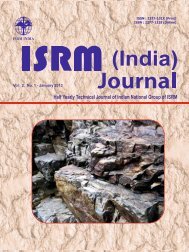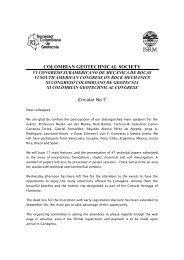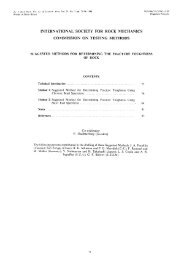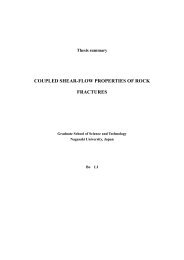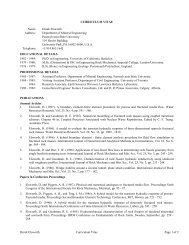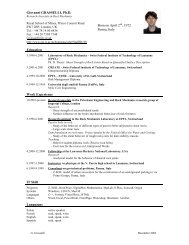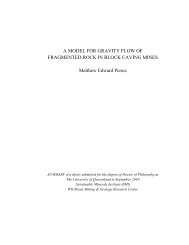Determination of Stress Orientation and Magnitude in a Directional Well bore, Case Study29(DSI). Figure 7 is a DSI log of this well which illustratesrock mass properties includes: uniaxial compressivestrength (UCS), Young’s modulus (E) and Poisson’sration (PR). In the first zone i.e., the Pabdeh formationUCS varies between 68 to 70 MPa. In the Gurpi formation,due to interbedded shale varies between 35 to 55 MPa.Since, Stonely wave which propagates from DSI toolattenuates and dissipates in permeable formations, anincrease in its velocity decreases the Young’s modulus(E) and UCS hence, it can be concluded that theenlargement of the wellbore seriously affects the rockproperties. In the Sarvak zone, the UCS value variesbetween 100 and 120 MPa. The stress polygon is basedon the Anderson’s faulting theory and Coulomb frictionaltheory. Whereas observed fractures on UBI are breakoutor compressional fractures, then the S His constrained instress polygon by applying UCS values in theseformations. Figure 8 and Figure 9 show constraining ofS Hin stress polygon at the Pabdeh and Sarvakformations. As S hwas obtained in previous section, thestress polygon can be obtained here by drawing thevertical dashed line from S haxis and constraining the S Husing horizontal dashed line. The above procedure canbe repeated for other formations as well. The Mansouri-54 wellbore is the directional wellbore with azimuth of25 ° to the north and 39 ° dip, horizontally. It is supposedto obtain stress around the wellbore in its direction. Thetransferred insitu stresses (S x, S yand S z) along thewellbore can be determined by substituting α =25 ° andi=39 ° and insitu stresses into transforming expressions(Fjaer et al. 2008, p.146)Fig. 7 : Dynamic rock mass propertiesin the Mansouri-54 wellbore.Fig. 8 : Stress polygon which describes magnitude of S Hinthe Pabdeh formation at 3012 m.Fig. 9 : Stress polygon which describes magnitude of S Hinthe Sarvak formation at 3485 m.Stress gradient in formations of the wellbore has beenshowed in Figure 10. However, the difference betweenthe mud pressure (P w) and the pore pressure show thatthe wellbore was drilled overbalance. The overpressurebalance (mud pressure minus pore pressure) was equalto 5MPa. According to Figure 10, stress gradientscorresponded to the strike slip faulting condition stressesi.e. S xa”S H>S za”S v>S ya” S h. It should be noticed that byincreasing the depth of the wellbore, the stress regimecan be changed from SS to NF and vice-versa.7. CONCLUSIONIn this study, orientation and magnitude of insitu stresseswere calculated in Mansouri-54 wellbore and hence, anoptimum trajectory for drilling could be obtained. Here,the vertical stress for interval depth (3012 to 3485 m)was obtained by integrating rock density from surface tothe depth. The minimum and the maximum horizontalstresses were calculated using practical relations andAnderson’s frictional theory, respectively. At the sametime, the DSI log was used to acquire the rock propertiesVolume 1 v No. 1 v January 2012
30 <strong>ISRM</strong> (India) JournalFig. 10 : Insitu Stresses, mud pressure and pore pressuregradients around the Mansouri-54 wellborehence; it was assumed that the rock behaviour isisotropic, elastic and homogenous. By obtaining thestress regime in the wellbore direction (=25 ° and i=39 ° ) itwas demonstrated that the stress regime corresponds tothe Strike Slip faulting (S xa”S H>S za”S v>S ya”S h). Theoptimum trajectory for stability during drilling is azimuthat which circumferential stress is minimized. Stableazimuth in the wellbore is S Hi.e. NE-SW. To minimizethe circumferential stress, the overpressure balance wasequal to 5 MPa.REFERENCESAlavi, M. 1994. Tectonics of the Zagros orogenic belt of Iran:new data and interpretations. Tectonophysics., 229, 211–238.Alavi, M. 2004. Regional stratigraphy of the Zagross fold-thrustbelt of Iran and its proforeland evolution. Am. J. Sci., 304, 1–20.Barton, C.A., Zoback, M.D. and Burns, K.L. 1988. Insitu stressorientation and magnitude at the Fenton geothermal site, NewMexico, determined from wellbore breakouts. Geophy. ResLett., 15 (5), 467–70.Bell, J.S. 1990. Investigating stress regimes in sedimentarybasins using information from oil industry wire line logs anddrilling records. Geol. Soc. Lond. Spec. Publ., 48, 305-325.Bell, J.S. 1996. Insitu stresses in sedimentary rocks (Part 1)Measurement techniques. Geoscience Canada., 23 (2), 85–100.Bell, J.S. 2003. Practical methods for estimating insitu stressesfor borehole stability applications in sedimentary basins. J.Pet. Sci. Eng., 38, 111-119.Brudy, M. et al. 1997. Estimation of the complete stress tensorto 8 km depth in the KTB scientific drill holes; implications forcrustal strength. JGR; 102-8:18,453±75.Fjaer, E. et al. 2008. Petroleum related rock mechanics. 2nded. Elsevier.Ireland, et al. 1992. The MDT Tool: A Wire line testingbreakthrough. Oilfield review.Khoshbakht, F., et al. 2009. Comparison of Asmari, Pabdehand Gurpi formation’s fractures, derived from image log.Journal of Petroleum Science and Engineering, 67, 65–74.Mottie, H. 1995. Geology of Iran; petroleum geology of Zagros.Geological Society of Iran publication, 37,(2), 1009 P.Navabpour, P., Angelier, J., and Barrier, E. 2007. Cenozoicpost-collisional brittle tectonic history and stress reorientationin the High Zagros Belt (Iran, Fars Province). Tectonophysics,432, 101–131.Nelson, et al. 2005. Transverse drilling-induced tensilefractures in the West Tuna area, Gippsland Basin, Australia:implications for the insitu stress regime. Int. J. Rock Mech.Min. Sci., 42, 361-371.Plumb R.A., and Hickman, S.H. 1985. Stress-induced boreholeenlargement: a comparison between the four-arm dip meterand the borehole televiewer in the Auburn geothermal wellbore.J. Geophys. Res., 90, 5513-5521.Reynolds, et al. 2006. Constraining stress magnitudes usingpetroleum exploration data in the Cooper–Eromanga Basins,Australia. Tectonophysics, 415, 123-140.Tingay, M., Reinecker, J., and Muller, B. 2008. Boreholebreakout and drilling-induced fracture analysis from imagelogs. World Stress Map Project.Willson, S.M., et al. 1999. Drilling in South America: a wellborestability approach for complex geologic conditions. SPE 53940.In: Sixth LACPEC conference. Caracas, Venezuela.Wiprut, D., and Zoback, M.D. 2000. Constraining the stresstensor in the Visund field, Norwegian North Sea: Applicationto wellbore stability and sand production. Int. J. Rock Mech.Min. Sci., 37, 317-336.Zoback, M. D., et al. 1985. Wellbore bore breakouts and insitustress. J. Geophys. Res., 90, 5523-5530.Zoback, M.D., et al. 1993. Upper crustal strength inferred fromstress measurements to 6 km depth in the KTB borehole.Nature, 365, 633±5.Zoback, M.D., et al. 2003. Determination of stress orientationand magnitude in deep wellbores. International Journal of RockMechanics & Mining Sciences, 40, 1049–1076.Volume 1 v No. 1 v January 2012






